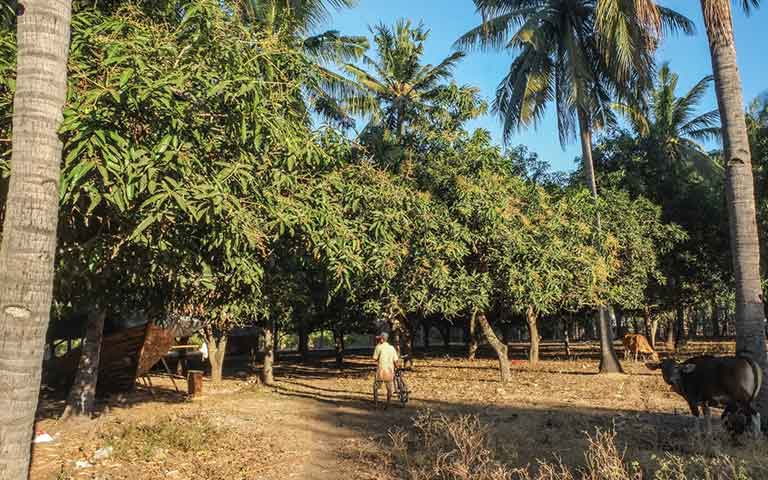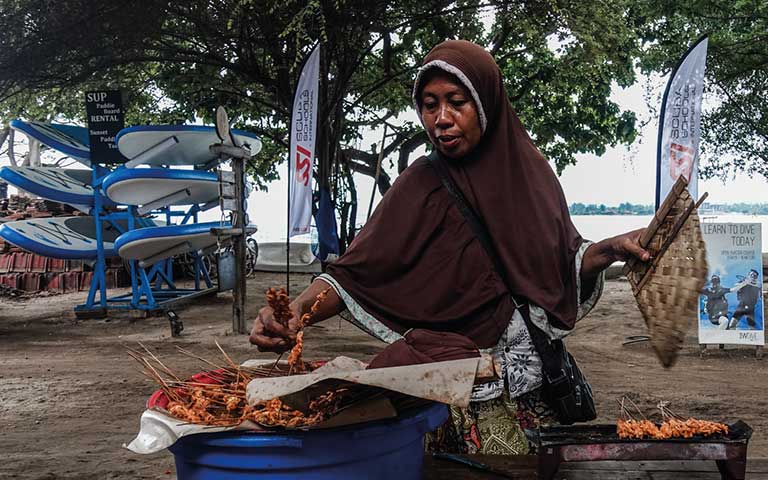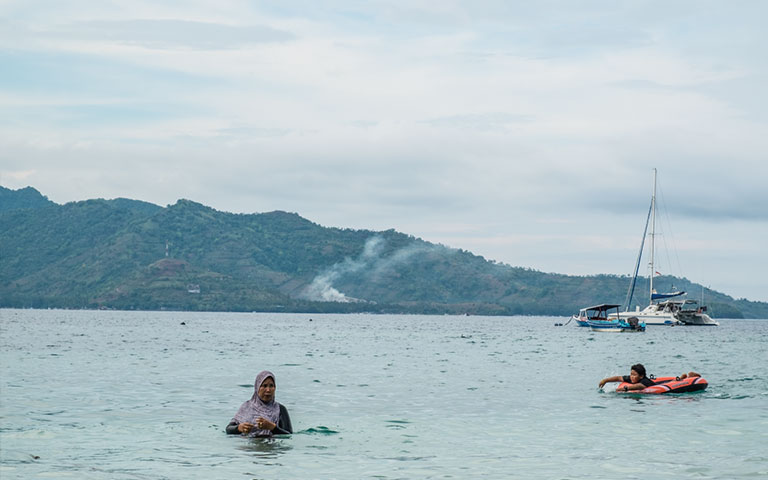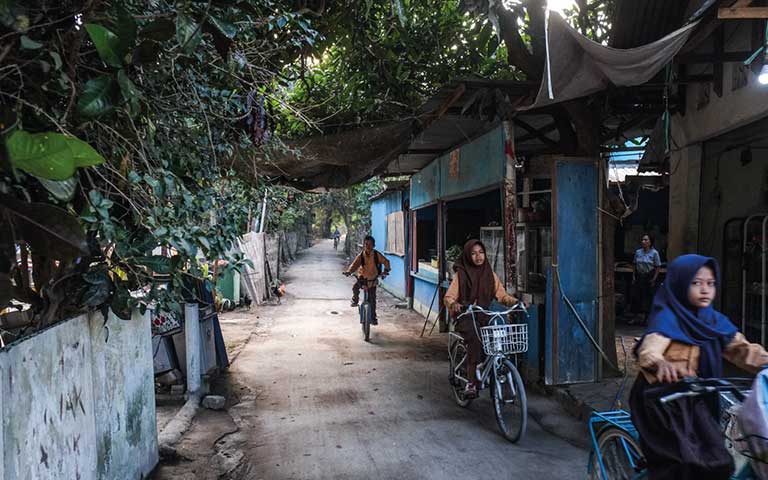by Joe Taylor
It seems fairly straight-forward. Each Gili island has a character of its own. Gili T has the parties, the reputation, and the countless reviews. Gili Meno has the peace, the tranquility, and the love. Gili Air, according to most, sits somewhere in the middle. But to truly enjoy life on the Gili Islands, you must first understand the people who discovered them, built them and now call them home.


History of the Gilis
The extended history of the Gilis is as hazy as the sun that bakes their dusty roads. That said, we do know that Bugis fishermen from Sulawesi used the islands as a rest stop during sea voyages. We also know that the Japanese military used the islands during the Second World War, both as a lookout post and prisoner of war camp. Remains of this can be seen by diving at the submerged wreck of a patrol boat south of Gili Air.
Yet, it wasn’t until the 1970s that life on the Gili Islands really began. To encourage coconut farming on the islands, the Governor of Lombok sent hundreds of prisoners to help with the cultivation. Life on the Gili Islands or overcrowded jail cell? We know what we’d choose. After several poor harvests, the private investors left the islands. This allowed the local Bugis and Sasak people to begin establishing communities.
A decade later the Gili Islands became known among backpackers as the new paradise islands of Indonesia. Bali’s popularity had risen, driving adventure seekers further afield. The seclusion of these destinations meant police presence was minimal, paving the way for drug tourism and a reputation for partying until sunrise.
The next wave of settlers came in the form of scuba divers. They recognized these waters to hold some of the best diving in the world. To this day there is a thriving local community within the Gilis and still very little police presence, creating a unique island vibe.
The next wave of settlers came in the form of scuba divers. They recognized these waters to hold some of the best diving in the world. To this day there is a thriving local community within the Gilis and still very little police presence, creating a unique island vibe.
People of the Gilis
The Gilis are mostly home to the Bugis and Sasak people who originate from Sulawesi and Lombok. Sasaks are the largest ethnic group on Lombok, numbering around 2.5 million. The Sasak language is related to Bahasa Indonesia but is still a different language. You may hear a selection of Sasak, Bahasa, English and even Sulawesi spoken on the islands. Most locals can speak enough of two or three of these languages to make communication possible.
Sasaks were traditionally farmers who produced goods like rice, coffee, coconuts, and sugarcane. Despite the increase in tourists and expats within the Gilis, each island still has its own local community. Many locals make the daily trip from Lombok for work, but if you venture inland and away from the beaches and bars, you’ll find awesome thriving villages.

Religion on the Gili Islands
Almost 90% of Indonesians now follow Islam, making it the largest Muslim nation in the world. Sasaks once practiced a unique blend of animism, Hinduism and Buddhism. It wasn’t until the 16th century when the religion of Islam began to take hold. This has created an interesting mix of Islamic and Hindu-Buddhist practices within the Sasak culture.
Wetu Telu (Three Times) and Waktu Lima (Five Times) are the two forms of Islam practiced within Lombok and the Gilis. The names refer to the number of times that followers pray per day. Waktu Lima is the more traditional Muslim religion while Wetu Telu has greater Hindu and Buddhist influences. All three of the islands have mosques, so it is common to hear the adman (call to prayer) being called throughout the day. The first of these mosques was built in Gili Air around 80 years ago and sits more or less in the center of the island.
Wetu Telu (Three Times) and Waktu Lima (Five Times) are the two forms of Islam practiced within Lombok and the Gilis. The names refer to the number of times that followers pray per day. Waktu Lima is the more traditional Muslim religion while Wetu Telu has greater Hindu and Buddhist influences. All three of the islands have mosques, so it is common to hear the adman (call to prayer) being called throughout the day. The first of these mosques was built in Gili Air around 80 years ago and sits more or less in the center of the island.


Culture and Life on the Gilis
As you now know, the Gilis are predominantly inhabited by Sasaks. So it should be no surprise that the culture and traditions are like those in Lombok. Yet, many of the traditional practices which attract tourism to Lombok are not replicated within the Gilis. This is likely due to increased tourist influence and the dominance of Waktu Lima. The mix of Islamic, Hindu and Buddhist influences has created a devoutly religious but hugely accepting culture. And, as with much of Indonesia, life on the Gili Islands is friendly, welcoming and slow-paced.
Mandi Safar is a common Indonesian custom performed throughout the Gilis. It involves ceremonial bathing in the ocean, followed by a shower, music, and food. This bathing ritual is intended to cleanse the soul of misfortunes such as accidents, disasters, and disease.
Mandi Safar is a common Indonesian custom performed throughout the Gilis. It involves ceremonial bathing in the ocean, followed by a shower, music, and food. This bathing ritual is intended to cleanse the soul of misfortunes such as accidents, disasters, and disease.
Gendang Beleq is a Sasak dance and music performance practiced during Mandi Safar, local weddings and other events. The band plays a selection of very large drums, symbols, gongs, and traditional flutes.


Which Gili Island to Choose
From the three islands, we chose Gili Air as a home for our tribe because it has the most authentic vibe. Despite being the first island to receive investment in infrastructure, the other two islands were quick to overtake Gili Air. Yet it is this understated development which provides that true feeling of escape. Having the largest local community within the Gilis also makes Gili Air unique. The villages here are full of amazing people whose lives are yet to be totally dominated by tourism. You will find these amazing people are quick to offer help and to instill a sense of belonging.
We needed no encouragement to trade in our mundane lives for a chilled and harmonious island paradise. It’s also a wicked coincidence that Gili Air is the perfect spot for a dive shop. The vibe is right, the water is warm and we have quick access to a variety of dive sites throughout the Gili Islands. And of course, it would be pointless visiting these sites if the sea life wasn’t awesome! We get to see loads of cool things every damn day. We’re talking big stuff like turtles and sharks and small things like mantis shrimp and nudibranchs.
No doubt you’re already planning your trip. But before you book return flights, check out our divemaster internship. Leave your worries at home and choose a life on the Gilis.
We needed no encouragement to trade in our mundane lives for a chilled and harmonious island paradise. It’s also a wicked coincidence that Gili Air is the perfect spot for a dive shop. The vibe is right, the water is warm and we have quick access to a variety of dive sites throughout the Gili Islands. And of course, it would be pointless visiting these sites if the sea life wasn’t awesome! We get to see loads of cool things every damn day. We’re talking big stuff like turtles and sharks and small things like mantis shrimp and nudibranchs.
No doubt you’re already planning your trip. But before you book return flights, check out our divemaster internship. Leave your worries at home and choose a life on the Gilis.

